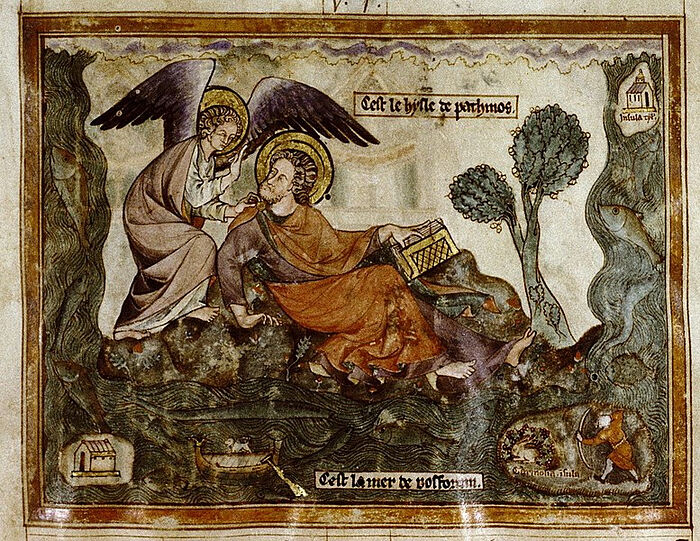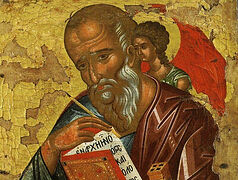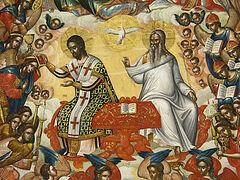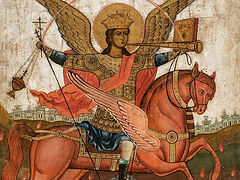Talk 4. On the Beatitudes of Revelation
Sergei Komarov is a well-known Orthodox writer and catechist based in Moscow.
 Douce Apocalypse - Bodleian Ms180. Photo: wikimedia.org
Douce Apocalypse - Bodleian Ms180. Photo: wikimedia.org
Greeting
Today we will examine the greeting of St. John the Theologian.
The greeting is a common part of any New Testament epistle. As a rule, the author wishes grace and peace to his addressees. Sometimes he names himself, and sometimes he designates to whom he is writing.
In this case, we have the following text:
John to the seven Churches which are in Asia: Grace be unto you, and peace, from Him Which is, and Which was, and Which is to come; and from the seven spirits which are before His throne; And from Jesus Christ, Who is the faithful witness, and the first begotten of the dead, and the prince of the kings of the earth (Rev. 1:4-5).
Which seven Churches are meant?
Which seven Churches is John referring to? He names them a little further on: What thou seest, write in a book, and send it unto the seven Churches which are in Asia; unto Ephesus, and unto Smyrna, and unto Pergamos, and unto Thyatira, and unto Sardis, and unto Philadelphia, and unto Laodicea (Rev. 1:11).
The Churches of the seven cities of Asia here have not only local but also universal significance—they symbolize the entire Church of Asia Minor and also the Ecumenical Church. Revelation is not just a circular, but an ecumenical message to the Church, relevant to every period of its existence.
This point is confirmed in Rev. 22:18. John assumes that every Christian will hear his message: For I testify unto every man that heareth the words of the prophecy of this book. Let us recall another line from St. John: He that hath an ear, let him hear what the Spirit saith unto the Churches (Rev. 2:7).
The first official list of the books of the New Testament—the Muratorian Canon—says of Revelation: “For John also, although he writes to seven Churches in Revelation, nevertheless addresses all.”
Symbolism of the number seven
The symbolic number seven also refers to the ecclesiastical fullness of the epistle to the Churches.
St. John often uses the symbolism of the number seven. It occurs 54 times in Revelation.
Seven here indicates (both fullness) and the state of the present age. Therefore, it seems the apostle distributes this epistle not only to the seven Churches or to the world in which he then lived, but to all future ages up until the destruction of the world. Therefore, he used the most sacred number and mentioned Asia, which is translated as ‘ascended’ or ‘marching,’ denoting, of course, the Heavenly fatherland that we call the catholic Church, ascended by the Lord and ever marching higher (Apringius of Beja).
We remind the readers that in describing the visions of Revelation, St. John uses a kind of “encrypted” language. Numbers, with their more theological or symbolic than mathematical meaning, are an integral part of the encrypted language of Revelation.
Seven symbolizes perfection, fullness, harmony. The seven Churches signify the fullness of the Ecumenical Church and the entire history of its earthly existence. In fact, through the apostle, Christ conveys peace and His blessing to all of us Christians.
The numerical symbolism of Revelation
Besides seven, the following numbers, the symbolism of which is also used in other books of the Bible, are used most often in Revelation:
6 (7-1) symbolizes imperfection as incomplete harmony, and therefore, deficiency, vice, and evil in general.
3.5 (7/2) symbolizes imperfection as a crisis (the critical point in the middle), as a time of trial, suffering, and persecution. This number usually indicates a time frame. It appears in different forms with various temporal content, maintaining one and the same specified meaning: And they shall be given into his hand until a time and times and the dividing of time (Dan. 7:25). Here 1+2+0.5=3.5 years.
The holy city shall they tread under foot forty and two months (Rev. 11:2, cf. 13:5). Forty-two months is the same three and a half years.
And they shall prophesy a thousand two hundred and threescore days (Rev. 11:3, cf. 12:6). 1,260 days is again three and a half years. However, we can also find three and a half days (cf. Rev. 11:9).
12 symbolizes Israel, made up of twelve tribes. In other words, it is the number of the people of God.
4 symbolizes the whole world (the four corners of the earth).
1,000 symbolizes an innumerable multitude.
These numbers can be used in combinations that strengthen the meaning. For example, 144,000=122x1,000. It means the people of God, who remain themselves in an innumerable multitude—Christian Israel, which has preserved its religious identity.
Many numbers are skillfully concealed in the fabric of the apocalyptic narrative. In the Revelation of St. John, the name “Jesus” is used fourteen times (7x2), and “Christ” seven times.
The number seven is one of the key symbols of Revelation. Later we will talk about the cycles of seven in Revelation: the epistle to the seven Churches, the vision of the seven seals, the seven trumpets, the seven bowls, etc.
Grace and peace from the Most Holy Trinity
Grace be unto you, and peace the apostle wishes his addressees. Archimandrite Januarius (Ivliev) comments, “Grace and peace are sent to the readers from God, Who is the Source of both, and Who is presented here in a very unusual three-part form: From Him Which is, and Which was, and Which is to come (from God the Father); and from the seven spirits which are before His throne; And from Jesus Christ. Quite justifiably, many commentators see here an unusual indication of the threeness of God.”
This is a very difficult point. Let us try to understand at least in part what St. John the Theologian wanted to say with the formula: From Him Which is, and Which was, and Which is to come; and from the seven spirits which are before His throne; And from Jesus Christ.
From Him Which is, and Which was, and Which is to come is literally translated: “The One Who exists and was and is coming”: ο ων—the existing One [I Am], και—and, ο ην—the One Who was, και—and, ο ερχόμενος—the coming One.
There are different understandings of this among the holy fathers and ecclesiastical writers. But we will speak about this in the next article.




